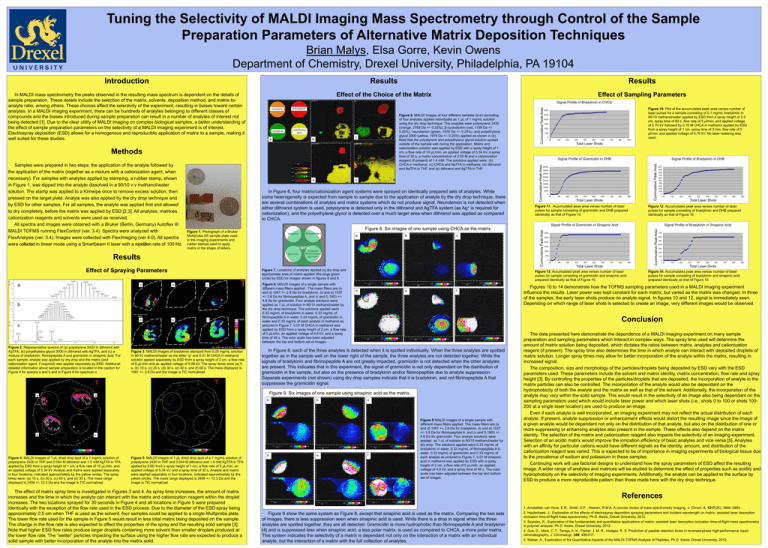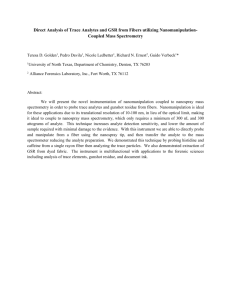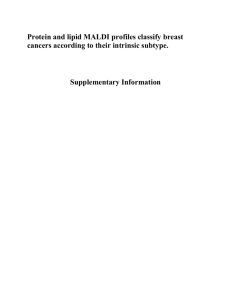Introduction
advertisement

Tuning the Selectivity of MALDI Imaging Mass Spectrometry through Control of the Sample Preparation Parameters of Alternative Matrix Deposition Techniques Brian Malys, Elsa Gorre, Kevin Owens Department of Chemistry, Drexel University, Philadelphia, PA 19104 Introduction Results Results In MALDI mass spectrometry the peaks observed in the resulting mass spectrum is dependent on the details of sample preparation. These details include the selection of the matrix, solvents, deposition method, and matrix-toanalyte ratio, among others. These choices affect the selectivity of the experiment, resulting in biases toward certain analytes. In a MALDI imaging experiment, there can be hundreds of analytes belonging to different classes of compounds and the biases introduced during sample preparation can result in a number of analytes of interest not being detected [1]. Due to the clear utility of MALDI imaging on complex biological samples, a better understanding of the effect of sample preparation parameters on the selectivity of a MALDI imaging experiment is of interest. Electrospray deposition (ESD) allows for a homogenous and reproducible application of matrix to a sample, making it well suited for these studies. Effect of the Choice of the Matrix Effect of Sampling Parameters In Figure 6, four matrix/cationization agent systems were sprayed on identically prepared sets of analytes. While some heterogeneity is expected from sample to sample due to the application of analyte by the dry drop technique, there are several combinations of analytes and matrix systems which do not produce signal. Neurotensin is not detected when either dithranol system is used, polystyrene is detected only in the dithranol and AgTFA system (as Ag+ is required for cationization), and the polyethylene glycol is detected over a much larger area when dithranol was applied as compared to CHCA. Intens. [a.u.] a 2352.782 bradykinin 200 3185.687 2040.468 3289.792 3497.881 Intens. [a.u.] 0 b 125 2154.366 1890.164 2198.380 1846.133 100 2242.429 1802.081 1758.063 75 2286.450 1713.994 50 2330.455 1669.960 1625.942 25 Intens. [a.u.] 2014_04_02 4analytes 4martixsystems 0:R00X162Y100 MS 2022.284 2374.455 2418.524 0 2014_05_07 CHCA and SA with pep mix 0:R01X183Y338 MS 1537.352 c 300 200 1619.418 1904.862 1060.897 100 1639.222 2128.767 0 1000 1500 2000 2500 b c matrix gramicidin bradykinin fibrinopeptide A gramicidin Figure 7. Locations of analytes applied by dry drop and approximate area of matrix applied (the large green circle) by ESD for images shown in figures 8 and 9. Figure 8. MALDI images of a single sample with different mass filters applied.. The mass filters are (a and d) 1061 +/- 2.6 Da for bradykinin, (b and e) 1537 +/- 3.8 Da for fibrinopeptide A, and (c and f) 1903 +/4.8 Da for gramicidin. Four analyte solutions were applied as 1 uL of solution in 90/10 methanol/water by the dry drop technique. The solutions applied were 0.33 mg/mL of bradykinin in water, 0.33 mg/mL of fibrinopeptide A in water, 0.33 mg/mL of gramicidin in water and 0.33 mg/mL of each analyte in methanol as pictured in Figure 7. 0.01 M CHCA in methanol was applied by ESD from a spray height of 2 cm, a flow rate of 5 μL/min, an applied voltage of 4.8 kV, and a spray time of 45 s. The color scale has been adjusted between the top and bottom set of images. 3081.587 1936.294 150 a 3000 3500 Figure 2. Representative spectra of (a) polystyrene 2430 in dithranol with AgTFA, (b) polyethylene glycol 2000 in dithranol with AgTFA, and (c) a mixture of bradykinin, fibrinopeptide A and gramicidin in sinapinic acid. For each sample, analyte was applied by dry drop and the matrix (and cationization agent, if required) was applied separately by ESD. Additional detailed information about sample preparation is located in the caption for Figure 4 for spectra a and b and in Figure 6 for spectrum c. Figure 3. MALDI Images of bradykinin stamped from 0.25 mg/mL solution in 90/10 methanol/water as the letter “g” and 0.01 M CHCA in methanol solution applied separately by ESD from a spray height of 2 cm, a flow rate of 5 μL/min and an applied voltage of 5.58 kV. The spray times were (a) 5 s, (b) 10 s, (c) 20 s, (d) 30 s, (e) 40 s, and (f) 60 s. The mass displayed is 1061 +/- 2.6 Da and the image is TIC normalized. d e f 500 0 00 100 200 300 400 500 600 700 800 900 Total Laser Shots Signal Profile of Bradykinin in DHB 40000 35000 30000 25000 20000 15000 10000 5000 0 00 100 200 300 400 500 600 700 800 900 Total Laser Shots Figure 11. Accumulated peak area verses number of laser pulses for sample consisting of gramicidin and DHB prepared identically as that of Figure 10. 1000 900 800 700 600 500 400 300 200 100 0 00 In Figure 8, each of the three analytes is detected when it is spotted individually. When the three analytes are spotted together as in the sample well on the lower right of the sample, the three analytes are not detected together. While the signals of bradykinin and fibrinopeptide A are not greatly impacted, gramicidin is not detected when the other analytes are present. This indicates that in this experiment, the signal of gramicidin is not only dependant on the distribution of gramicidin in the sample, but also on the presence of bradykinin and/or fibrinopeptide due to analyte suppression. Separate experiments (not shown) using dry drop samples indicate that it is bradykinin, and not fibrinopeptide A that suppresses the gramicidin signal. a Figure 5 MALDI images of 1 μL dried drop spot of a 1 mg/mL solution of polystyrene 2430 in THF and 0.044 M dithranol and 1.5 mM AgTFA in TFA applied by ESD from a spray height of 1 cm, a flow rate of 5 μL/min, an applied voltage of 5.34 kV, and a spray time of 30 s. Analyte and matrix were applied separately in four locations, indicated approximately by the yellow circles. The mass range displayed is 2456 +/- 12.3 Da and the image is TIC normalized. The effect of matrix spray time is investigated in Figures 3 and 4. As spray time increases, the amount of matrix increases and the time in which the analyte can interact with the matrix and cationization reagent within the droplet increases. The two locations sprayed for 30 seconds in Figure 4 and all locations in Figure 5 were prepared identically with the exception of the flow rate used in the ESD process. Due to the diameter of the ESD spray being approximately 0.5 cm when THF is used as the solvent, four samples could be applied to a single Multiprobe plate. The lower flow rate used for the sample in Figure 5 would result in less total matrix being deposited on the sample. The change in the flow rate is also expected to affect the properties of the spray and the resulting solid sample [3]. Note that higher ESD flow rates produce larger droplets containing more solvent than smaller droplets produced at the lower flow rate. The “wetter” particles impacting the surface using the higher flow rate are expected to produce a solid sample with better incorporation of the analyte into the matrix solid. d b e 2500 2000 1500 1000 500 0 100 200 300 400 500 600 700 200 300 400 500 600 700 800 900 Total Laser Shots Figure 12. Accumulated peak area verses number of laser pulses for sample consisting of bradykinin and DHB prepared identically as that of Figure 10. Signal Profile of Bradykinin in Sinapinic Acid 3000 00 100 800 Total Laser Shots 900 700 600 500 400 300 200 100 0 00 100 200 300 400 500 600 700 800 900 Total Laser Shots Figure 14. Accumulated peak area verses number of laser pulses for sample consisting of bradykinin and sinapinic acid prepared identically as that of Figure 10. Figures 10 to 14 demonstrate how the TOFMS sampling parameters used in a MALDI imaging experiment influence the results. Laser power was kept constant for each matrix, but varied as the matrix was changed. In three of the samples, the early laser shots produce no analyte signal. In figures 10 and 12, signal is immediately seen. Depending on which range of laser shots is selected to create an image, very different images would be observed. Conclusion Figure 9. Six images of one sample using sinapinic acid as the matrix. Figure 4. MALDI images of 1 μL dried drop spot of a 1 mg/mL solution of polystyrene 2430 in THF and 0.044 M dithranol and 1.5 mM AgTFA in TFA applied by ESD from a spray height of 1 cm, a flow rate of 10 μL/min, and an applied voltage of 5.34 kV. Analyte and matrix were applied separately in four locations, indicated approximately by the yellow circles. The spray times were: (a) 15 s, (b) 30 s, (c) 45 s, and (d) 30 s. The mass range displayed is 2456 +/- 12.3 Da and the image is TIC normalized. 1000 Figure 13. Accumulated peak area verses number of laser pulses for sample consisting of gramicidin and sinapinic acid prepared identically as that of Figure 10. 2014_04_02 4analytes 4martixsystems 0:R00X131Y093 MS 2977.499 2144.572 100 fibrinopeptide A 2769.259 2873.390 2248.655 1500 Cummulative Peak Area Figure 8. Six images of one sample using CHCA as the matrix. Figure 1. Photograph of a Bruker Multiprobe SS sample plate used in the imaging experiments and rubber stamps used to apply matrix in the shape of letters. Effect of Spraying Parameters 300 2000 Signal Profile of Gramicidin in Sinapinic Acid Results 2456.907 2500 Figure 10. Plot of the accumulated peak area verses number of laser pulses for a sample consisting of 0.1 mg/mL bradykinin in 90/10 methanol/water applied by ESD from a spray height of 2.5 cm, spray time of 60 s, flow rate of 5 μl/min, and applied voltage of 5.70 kV followed by 0.10 M CHCA in methanol applied by ESD from a spray height of 1 cm, spray time of 3 min, flow rate of 5 μl/min, and applied voltage of 5.70 kV. No laser rastering was used. Signal Profile of Gramicidin in DHB Cummulative Peak Area Samples were prepared in two steps: the application of the analyte followed by the application of the matrix (together as a mixture with a cationization agent, when necessary). For samples with analytes applied by stamping, a rubber stamp, shown in Figure 1, was dipped into the analyte dissolved in a 90/10 v:v methanol/water solution. The stamp was applied to a Kimwipe once to remove excess solution, then pressed on the target plate. Analyte was also applied by the dry drop technique and by ESD for other samples. For all samples, the analyte was applied first and allowed to dry completely, before the matrix was applied by ESD [2,3]. All analytes, matrices, cationization reagents and solvents were used as received. All spectra and images were obtained with a Bruker (Berlin, Germany) Autoflex III MALDI TOFMS running FlexControl (ver. 3.4). Spectra were analyzed with FlexAnalysis (ver. 3.4). Images were collected with FlexImaging (ver 4.0). All spectra were collected in linear mode using a Smartbeam II laser with a repetition rate of 100 Hz. 3000 Cummulative Peak Area Methods Cummulative Peak Area Figure 6. MALDI images of four different samples (b-e) consisting of four analytes applied individually as 1 μL of 1 mg/mL solution using the dry drop technique. The analytes were polystyrene 2430 (orange, 2769 Da +/- 0.25%), β-cyclodextrin (red, 1159 Da +/0.25%), neurotensin (green, 1676 Da +/- 0.25%), and polyethylene glycol 2000 (yellow, 1978 Da +/- 0.25%) applied as shown in (a). Note that the polystyrene and polyethylene glycol solution spread outside of the sample well during the application. Matrix and cationization solution was applied by ESD with a spray height of 1 cm, a flow rate of 10 μL/min, an applied voltage of 5.34 kV, a spray time of 30 s, a matrix concentration of 0.05 M and a cationization reagent (if present) of 1.4 mM. The solutions applied were: (b) CHCA in methanol, (c) CHCA and NaTFA in methanol, (d) dithranol and NaTFA in THF, and (e) dithranol and AgTFA in THF. Cummulative Peak Area Signal Profile of Bradykinin in CHCA c f Figure 9 MALDI images of a single sample with different mass filters applied. The mass filters are (a and d) 1061 +/- 2.6 Da for bradykinin, (b and e) 1537 +/- 3.8 Da for fibrinopeptide A, and (c and f) 1903 +/4.8 Da for gramicidin. Four analyte solutions were applied as 1 uL of solution in 90/10 methanol/water by dry drop. The solutions applied were 0.33 mg/mL of bradykinin in water, 0.33 mg/mL of fibrinopeptide A in water, 0.33 mg/mL of gramicidin and 0.33 mg/mL of each analyte as pictured in Figure 7. 0.01 M sinapinic acid in methanol was applied by ESD with a spray height of 2 cm, a flow rate of 5 μL/min, an applied voltage of 4.8 kV, and a spray time of 45 s. The color scale has been adjusted between the top and bottom set of images. The data presented here demonstrate the dependence of a MALDI imaging experiment on many sample preparation and sampling parameters which interact in complex ways. The spray time used will determine the amount of matrix solution being deposited, which dictates the ratios between matrix, analytes and cationization reagent (if present). The spray time also determines the time in which analyte can interact with deposited droplets of matrix solution. Longer spray times may allow for better incorporation of the analyte within the matrix, resulting in increased signal. The composition, size and morphology of the particles/droplets being deposited by ESD vary with the ESD parameters used. These parameters include the solvent and matrix identity, matrix concentration, flow rate and spray height [3]. By controlling the properties of the particles/droplets that are deposited, the incorporation of analyte in the matrix particles can also be controlled. The incorporation of the analyte would also be dependant on the hydrophobicity of both the analyte and the matrix as well as that of the solvent. Additionally, the incorporation of the analyte may vary within the solid sample. This would result in the selectivity of an image also being dependant on the sampling parameters used which would include laser power and which laser shots (i.e., shots 0 to 100 or shots 100200 at a single laser location) are used to produce an image. Even if each analyte is well incorporated, an imaging experiment may not reflect the actual distribution of each analyte. If present, analyte suppression or enhancement effects would distort the resulting image since the image of a given analyte would be dependant not only on the distribution of that analyte, but also on the distribution of one or more suppressing or enhancing analytes also present in the sample. These effects also depend on the matrix identity. The selection of the matrix and cationization reagent also impacts the selectivity of an imaging experiment. Selection of an acidic matrix would improve the ionization efficiency of basic analytes and vice versa [5]. Analytes with an affinity for particular cations would have different signals as the identity, amount, and distribution of the cationization reagent was varied. This is expected to be of importance in imaging experiments of biological tissue due to the prevalence of sodium and potassium in these samples. Continuing work will use factorial designs to understand how the spray parameters of ESD affect the resulting image. A wider range of analytes and matrices will be studied to determine the effect of properties such as acidity and hydrophobicity on the selectivity of imaging experiments. Additionally, the analyte can be applied to the surface by ESD to produce a more reproducible pattern than those made here with the dry drop technique. References Figure 9 show the same system as Figure 8, except that sinapinic acid is used as the matrix. Comparing the two sets of images, there is less suppression seen when sinapinic acid is used. While there is a drop in signal when the three analytes are spotted together, they are all detected. Gramicidin is more hydrophobic than fibrinopeptide A and bradykinin [4] and is suppressed less when sinapinic acid, a less polar matrix, is used as compared to CHCA, a more polar matrix. This system indicates the selectivity of a matrix is dependant not only on the interaction of a matrix with an individual analyte, but the interaction of a matrix with the full collection of analytes. 1. Amstalden van Hove, E.R., Smith, D.F. , Heeren, R.M.A. A concise review of mass spectrometry imaging, J. Chrom. A, 1217(25), 3946–3954. 2. Haulenbeek, J., Exploration of the effects of electrospray deposition spraying parameters and incident wavelength on matrix- assisted laser desorption ionization time-of-flight mass spectrometry, Ph.D. thesis, Drexel University, 2012. 3. Szyszka, R., Exploration of the fundamentals and quantitative applications of matrix- assisted laser desorption ionization time-of-flight mass spectrometry in polymer analysis, Ph.D. thesis, Drexel University, 2012. 4. Guo, D., Mant, C. T., Taneja, A. K., Parker, J. M. R., Hodges, R. S. Prediction of peptide retention times in reversed-phase high-performance liquid chromatography. J. Chromatogr. 359, 499-517. 5. Mahan, A., Exploration of the Quantitative Aspects of the MALDI TOFMS Analysis of Peptides, Ph.D. thesis, Drexel University, 2012.






